Critical Analysis of Women in Management: HR Strategies Report
VerifiedAdded on 2021/11/12
|10
|2919
|21
Report
AI Summary
This report provides a critical analysis of the diversity issues faced by women in management, focusing on Human Resource Development (HRD) and rewarding strategies. It examines challenges like inflexible work arrangements, wage gaps, and lack of role models, proposing solutions such as flexible work environments, equal pay, and sponsorship programs. The report utilizes theories like contingency theory and Maslow's Hierarchy of Needs to support its arguments. Furthermore, it explores issues in rewarding human resources, including promotional biases and limited leadership opportunities. Recommendations include providing training, equal opportunities, and fair promotion practices. The report concludes that implementing these HR strategies is crucial for diminishing gender inequality and fostering a more inclusive and equitable workplace for women in management. It emphasizes the need for organizations to create supportive environments that recognize and reward women's contributions.
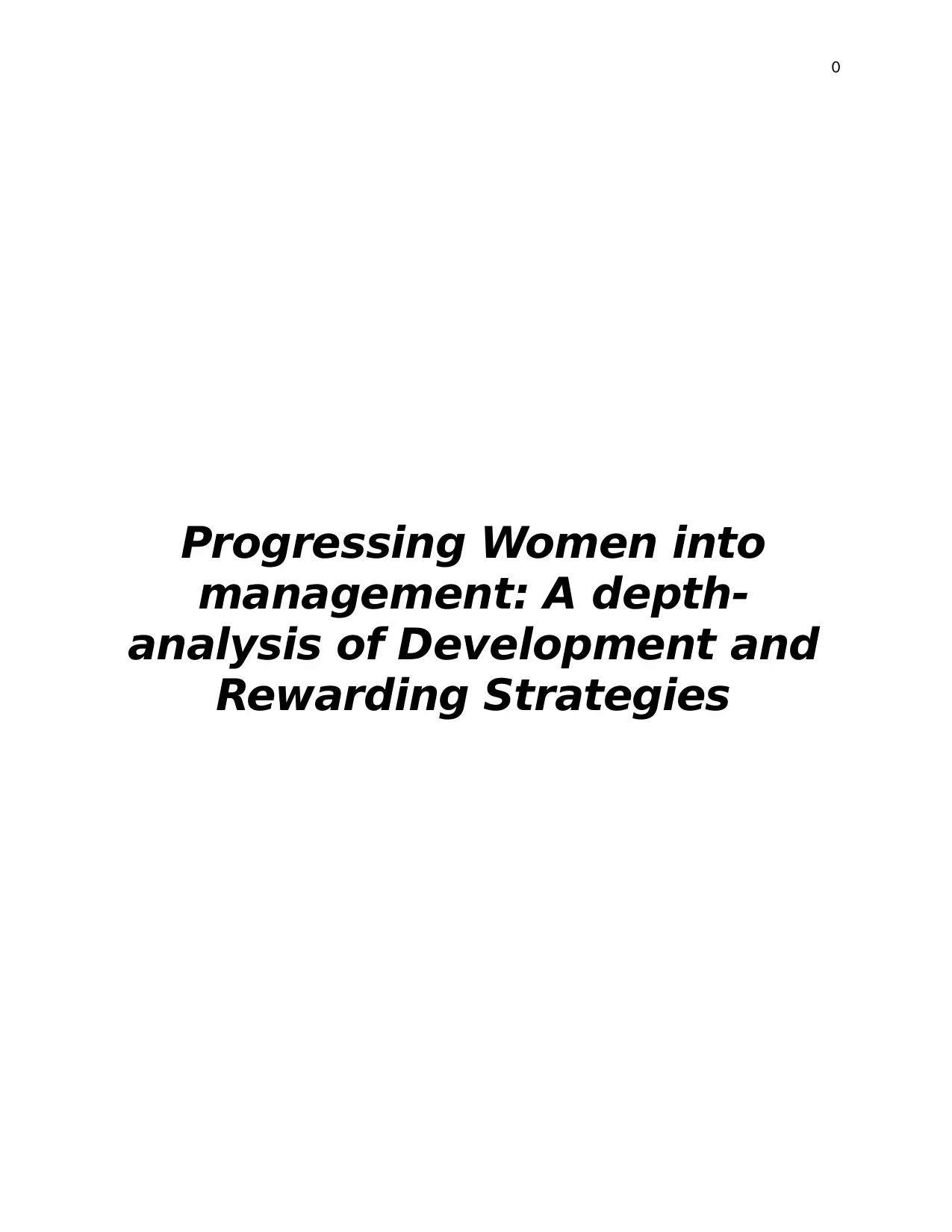
0
Progressing Women into
management: A depth-
analysis of Development and
Rewarding Strategies
Progressing Women into
management: A depth-
analysis of Development and
Rewarding Strategies
Paraphrase This Document
Need a fresh take? Get an instant paraphrase of this document with our AI Paraphraser
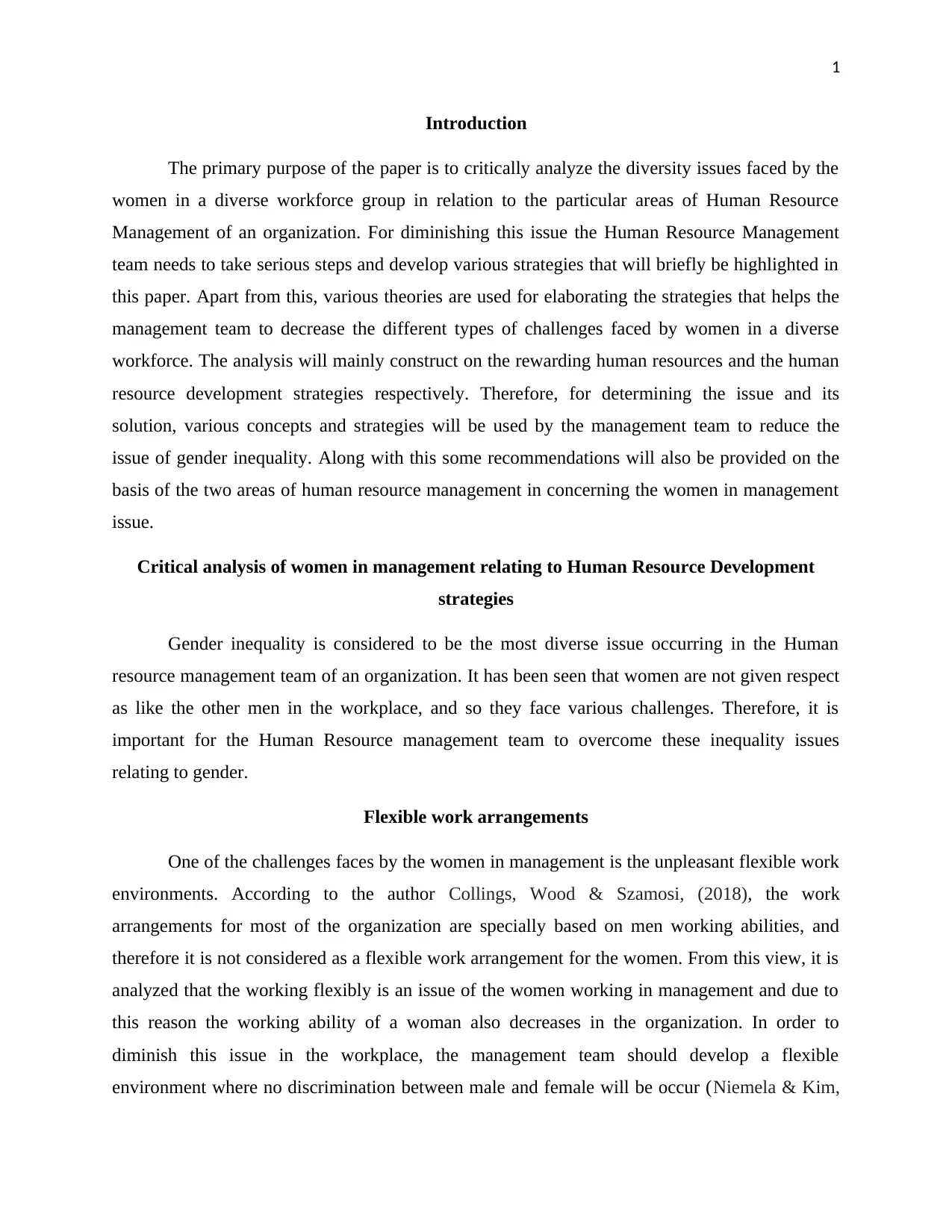
1
Introduction
The primary purpose of the paper is to critically analyze the diversity issues faced by the
women in a diverse workforce group in relation to the particular areas of Human Resource
Management of an organization. For diminishing this issue the Human Resource Management
team needs to take serious steps and develop various strategies that will briefly be highlighted in
this paper. Apart from this, various theories are used for elaborating the strategies that helps the
management team to decrease the different types of challenges faced by women in a diverse
workforce. The analysis will mainly construct on the rewarding human resources and the human
resource development strategies respectively. Therefore, for determining the issue and its
solution, various concepts and strategies will be used by the management team to reduce the
issue of gender inequality. Along with this some recommendations will also be provided on the
basis of the two areas of human resource management in concerning the women in management
issue.
Critical analysis of women in management relating to Human Resource Development
strategies
Gender inequality is considered to be the most diverse issue occurring in the Human
resource management team of an organization. It has been seen that women are not given respect
as like the other men in the workplace, and so they face various challenges. Therefore, it is
important for the Human Resource management team to overcome these inequality issues
relating to gender.
Flexible work arrangements
One of the challenges faces by the women in management is the unpleasant flexible work
environments. According to the author Collings, Wood & Szamosi, (2018), the work
arrangements for most of the organization are specially based on men working abilities, and
therefore it is not considered as a flexible work arrangement for the women. From this view, it is
analyzed that the working flexibly is an issue of the women working in management and due to
this reason the working ability of a woman also decreases in the organization. In order to
diminish this issue in the workplace, the management team should develop a flexible
environment where no discrimination between male and female will be occur (Niemela & Kim,
Introduction
The primary purpose of the paper is to critically analyze the diversity issues faced by the
women in a diverse workforce group in relation to the particular areas of Human Resource
Management of an organization. For diminishing this issue the Human Resource Management
team needs to take serious steps and develop various strategies that will briefly be highlighted in
this paper. Apart from this, various theories are used for elaborating the strategies that helps the
management team to decrease the different types of challenges faced by women in a diverse
workforce. The analysis will mainly construct on the rewarding human resources and the human
resource development strategies respectively. Therefore, for determining the issue and its
solution, various concepts and strategies will be used by the management team to reduce the
issue of gender inequality. Along with this some recommendations will also be provided on the
basis of the two areas of human resource management in concerning the women in management
issue.
Critical analysis of women in management relating to Human Resource Development
strategies
Gender inequality is considered to be the most diverse issue occurring in the Human
resource management team of an organization. It has been seen that women are not given respect
as like the other men in the workplace, and so they face various challenges. Therefore, it is
important for the Human Resource management team to overcome these inequality issues
relating to gender.
Flexible work arrangements
One of the challenges faces by the women in management is the unpleasant flexible work
environments. According to the author Collings, Wood & Szamosi, (2018), the work
arrangements for most of the organization are specially based on men working abilities, and
therefore it is not considered as a flexible work arrangement for the women. From this view, it is
analyzed that the working flexibly is an issue of the women working in management and due to
this reason the working ability of a woman also decreases in the organization. In order to
diminish this issue in the workplace, the management team should develop a flexible
environment where no discrimination between male and female will be occur (Niemela & Kim,
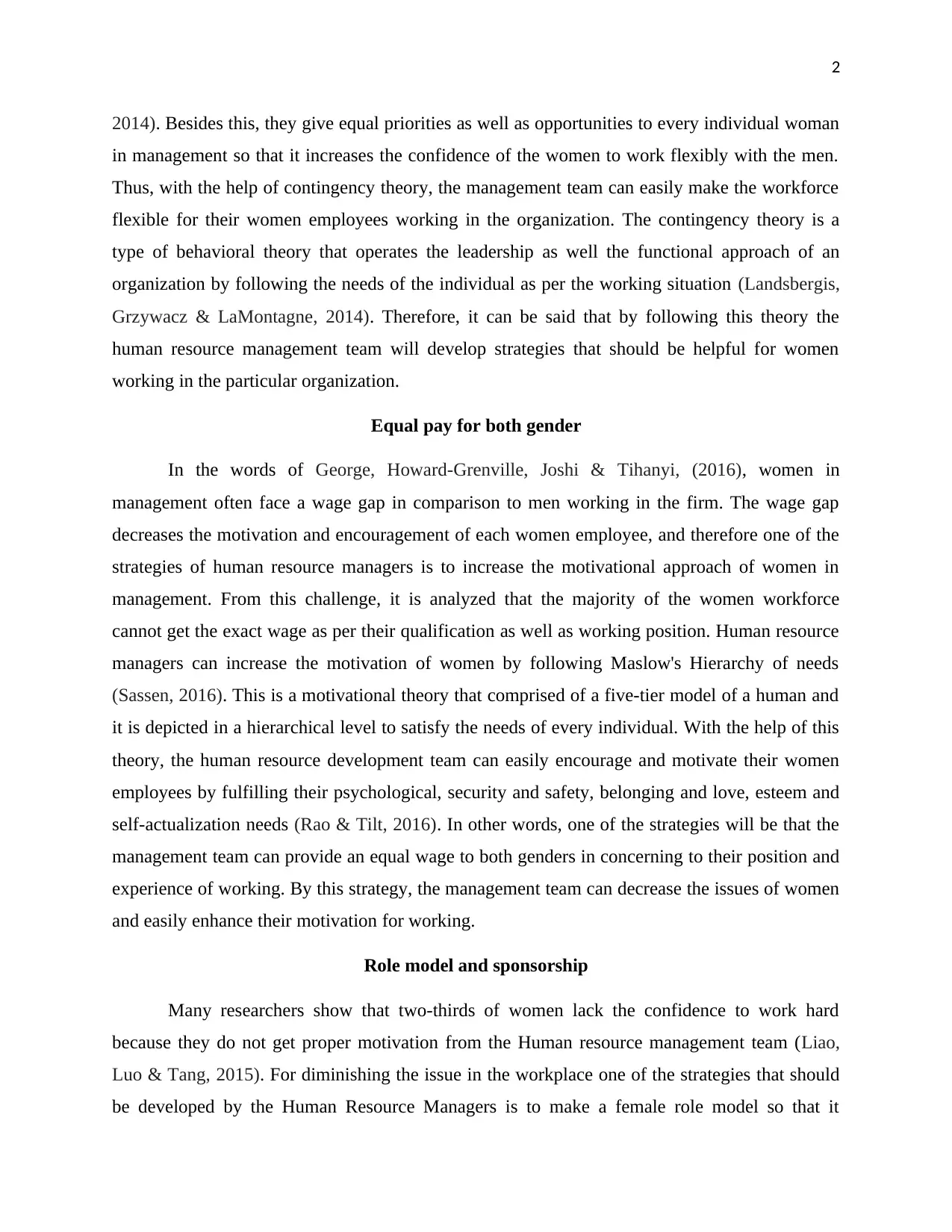
2
2014). Besides this, they give equal priorities as well as opportunities to every individual woman
in management so that it increases the confidence of the women to work flexibly with the men.
Thus, with the help of contingency theory, the management team can easily make the workforce
flexible for their women employees working in the organization. The contingency theory is a
type of behavioral theory that operates the leadership as well the functional approach of an
organization by following the needs of the individual as per the working situation (Landsbergis,
Grzywacz & LaMontagne, 2014). Therefore, it can be said that by following this theory the
human resource management team will develop strategies that should be helpful for women
working in the particular organization.
Equal pay for both gender
In the words of George, Howard-Grenville, Joshi & Tihanyi, (2016), women in
management often face a wage gap in comparison to men working in the firm. The wage gap
decreases the motivation and encouragement of each women employee, and therefore one of the
strategies of human resource managers is to increase the motivational approach of women in
management. From this challenge, it is analyzed that the majority of the women workforce
cannot get the exact wage as per their qualification as well as working position. Human resource
managers can increase the motivation of women by following Maslow's Hierarchy of needs
(Sassen, 2016). This is a motivational theory that comprised of a five-tier model of a human and
it is depicted in a hierarchical level to satisfy the needs of every individual. With the help of this
theory, the human resource development team can easily encourage and motivate their women
employees by fulfilling their psychological, security and safety, belonging and love, esteem and
self-actualization needs (Rao & Tilt, 2016). In other words, one of the strategies will be that the
management team can provide an equal wage to both genders in concerning to their position and
experience of working. By this strategy, the management team can decrease the issues of women
and easily enhance their motivation for working.
Role model and sponsorship
Many researchers show that two-thirds of women lack the confidence to work hard
because they do not get proper motivation from the Human resource management team (Liao,
Luo & Tang, 2015). For diminishing the issue in the workplace one of the strategies that should
be developed by the Human Resource Managers is to make a female role model so that it
2014). Besides this, they give equal priorities as well as opportunities to every individual woman
in management so that it increases the confidence of the women to work flexibly with the men.
Thus, with the help of contingency theory, the management team can easily make the workforce
flexible for their women employees working in the organization. The contingency theory is a
type of behavioral theory that operates the leadership as well the functional approach of an
organization by following the needs of the individual as per the working situation (Landsbergis,
Grzywacz & LaMontagne, 2014). Therefore, it can be said that by following this theory the
human resource management team will develop strategies that should be helpful for women
working in the particular organization.
Equal pay for both gender
In the words of George, Howard-Grenville, Joshi & Tihanyi, (2016), women in
management often face a wage gap in comparison to men working in the firm. The wage gap
decreases the motivation and encouragement of each women employee, and therefore one of the
strategies of human resource managers is to increase the motivational approach of women in
management. From this challenge, it is analyzed that the majority of the women workforce
cannot get the exact wage as per their qualification as well as working position. Human resource
managers can increase the motivation of women by following Maslow's Hierarchy of needs
(Sassen, 2016). This is a motivational theory that comprised of a five-tier model of a human and
it is depicted in a hierarchical level to satisfy the needs of every individual. With the help of this
theory, the human resource development team can easily encourage and motivate their women
employees by fulfilling their psychological, security and safety, belonging and love, esteem and
self-actualization needs (Rao & Tilt, 2016). In other words, one of the strategies will be that the
management team can provide an equal wage to both genders in concerning to their position and
experience of working. By this strategy, the management team can decrease the issues of women
and easily enhance their motivation for working.
Role model and sponsorship
Many researchers show that two-thirds of women lack the confidence to work hard
because they do not get proper motivation from the Human resource management team (Liao,
Luo & Tang, 2015). For diminishing the issue in the workplace one of the strategies that should
be developed by the Human Resource Managers is to make a female role model so that it
⊘ This is a preview!⊘
Do you want full access?
Subscribe today to unlock all pages.

Trusted by 1+ million students worldwide
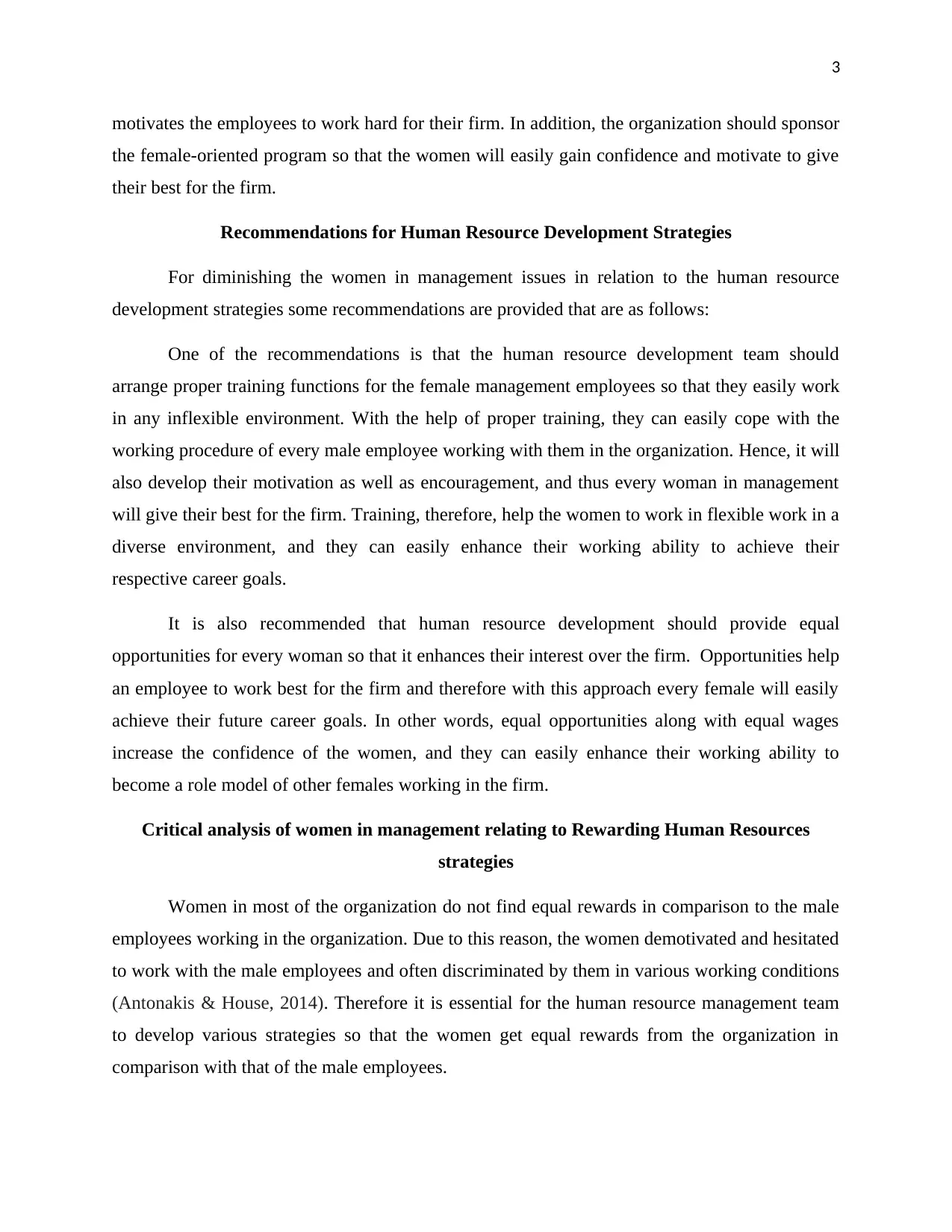
3
motivates the employees to work hard for their firm. In addition, the organization should sponsor
the female-oriented program so that the women will easily gain confidence and motivate to give
their best for the firm.
Recommendations for Human Resource Development Strategies
For diminishing the women in management issues in relation to the human resource
development strategies some recommendations are provided that are as follows:
One of the recommendations is that the human resource development team should
arrange proper training functions for the female management employees so that they easily work
in any inflexible environment. With the help of proper training, they can easily cope with the
working procedure of every male employee working with them in the organization. Hence, it will
also develop their motivation as well as encouragement, and thus every woman in management
will give their best for the firm. Training, therefore, help the women to work in flexible work in a
diverse environment, and they can easily enhance their working ability to achieve their
respective career goals.
It is also recommended that human resource development should provide equal
opportunities for every woman so that it enhances their interest over the firm. Opportunities help
an employee to work best for the firm and therefore with this approach every female will easily
achieve their future career goals. In other words, equal opportunities along with equal wages
increase the confidence of the women, and they can easily enhance their working ability to
become a role model of other females working in the firm.
Critical analysis of women in management relating to Rewarding Human Resources
strategies
Women in most of the organization do not find equal rewards in comparison to the male
employees working in the organization. Due to this reason, the women demotivated and hesitated
to work with the male employees and often discriminated by them in various working conditions
(Antonakis & House, 2014). Therefore it is essential for the human resource management team
to develop various strategies so that the women get equal rewards from the organization in
comparison with that of the male employees.
motivates the employees to work hard for their firm. In addition, the organization should sponsor
the female-oriented program so that the women will easily gain confidence and motivate to give
their best for the firm.
Recommendations for Human Resource Development Strategies
For diminishing the women in management issues in relation to the human resource
development strategies some recommendations are provided that are as follows:
One of the recommendations is that the human resource development team should
arrange proper training functions for the female management employees so that they easily work
in any inflexible environment. With the help of proper training, they can easily cope with the
working procedure of every male employee working with them in the organization. Hence, it will
also develop their motivation as well as encouragement, and thus every woman in management
will give their best for the firm. Training, therefore, help the women to work in flexible work in a
diverse environment, and they can easily enhance their working ability to achieve their
respective career goals.
It is also recommended that human resource development should provide equal
opportunities for every woman so that it enhances their interest over the firm. Opportunities help
an employee to work best for the firm and therefore with this approach every female will easily
achieve their future career goals. In other words, equal opportunities along with equal wages
increase the confidence of the women, and they can easily enhance their working ability to
become a role model of other females working in the firm.
Critical analysis of women in management relating to Rewarding Human Resources
strategies
Women in most of the organization do not find equal rewards in comparison to the male
employees working in the organization. Due to this reason, the women demotivated and hesitated
to work with the male employees and often discriminated by them in various working conditions
(Antonakis & House, 2014). Therefore it is essential for the human resource management team
to develop various strategies so that the women get equal rewards from the organization in
comparison with that of the male employees.
Paraphrase This Document
Need a fresh take? Get an instant paraphrase of this document with our AI Paraphraser

4
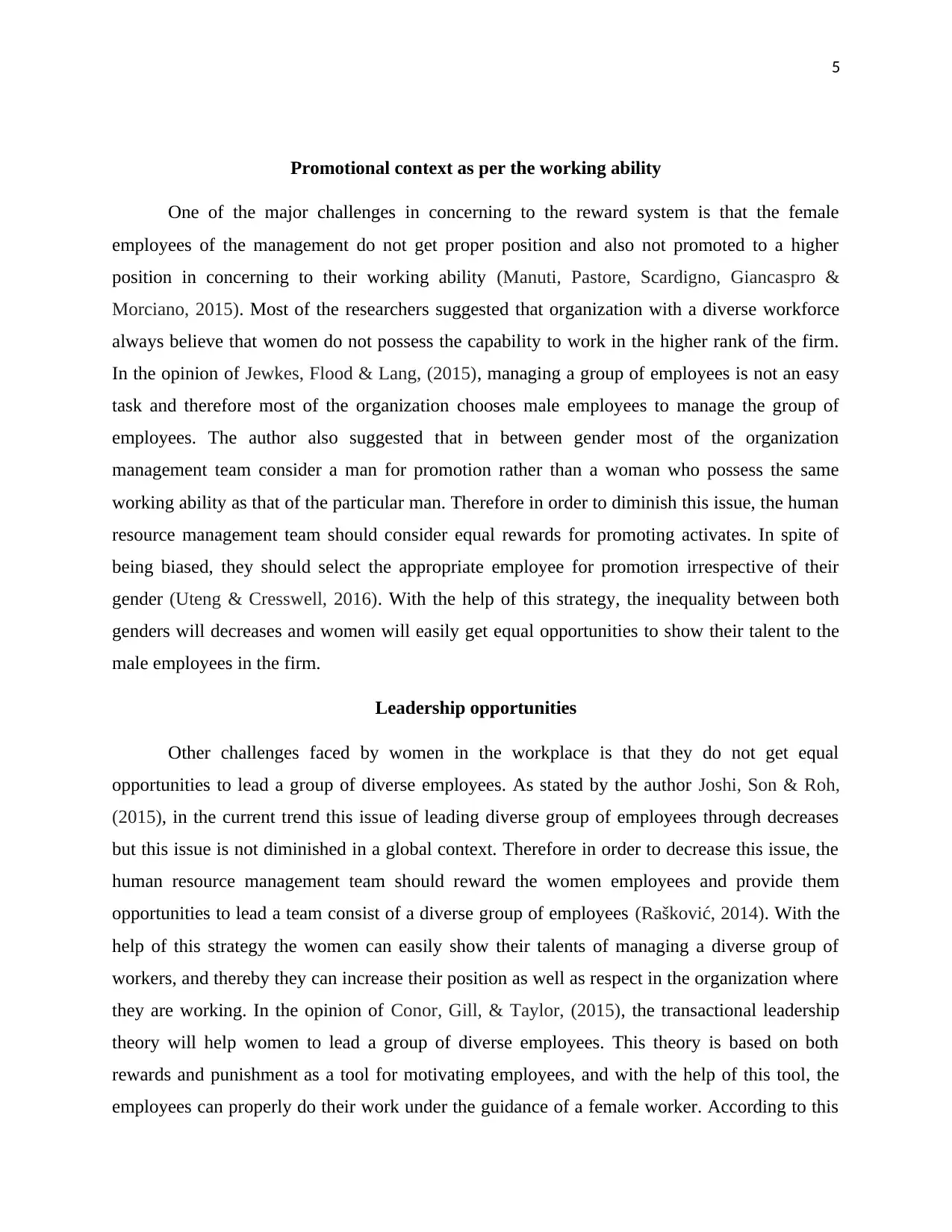
5
Promotional context as per the working ability
One of the major challenges in concerning to the reward system is that the female
employees of the management do not get proper position and also not promoted to a higher
position in concerning to their working ability (Manuti, Pastore, Scardigno, Giancaspro &
Morciano, 2015). Most of the researchers suggested that organization with a diverse workforce
always believe that women do not possess the capability to work in the higher rank of the firm.
In the opinion of Jewkes, Flood & Lang, (2015), managing a group of employees is not an easy
task and therefore most of the organization chooses male employees to manage the group of
employees. The author also suggested that in between gender most of the organization
management team consider a man for promotion rather than a woman who possess the same
working ability as that of the particular man. Therefore in order to diminish this issue, the human
resource management team should consider equal rewards for promoting activates. In spite of
being biased, they should select the appropriate employee for promotion irrespective of their
gender (Uteng & Cresswell, 2016). With the help of this strategy, the inequality between both
genders will decreases and women will easily get equal opportunities to show their talent to the
male employees in the firm.
Leadership opportunities
Other challenges faced by women in the workplace is that they do not get equal
opportunities to lead a group of diverse employees. As stated by the author Joshi, Son & Roh,
(2015), in the current trend this issue of leading diverse group of employees through decreases
but this issue is not diminished in a global context. Therefore in order to decrease this issue, the
human resource management team should reward the women employees and provide them
opportunities to lead a team consist of a diverse group of employees (Rašković, 2014). With the
help of this strategy the women can easily show their talents of managing a diverse group of
workers, and thereby they can increase their position as well as respect in the organization where
they are working. In the opinion of Conor, Gill, & Taylor, (2015), the transactional leadership
theory will help women to lead a group of diverse employees. This theory is based on both
rewards and punishment as a tool for motivating employees, and with the help of this tool, the
employees can properly do their work under the guidance of a female worker. According to this
Promotional context as per the working ability
One of the major challenges in concerning to the reward system is that the female
employees of the management do not get proper position and also not promoted to a higher
position in concerning to their working ability (Manuti, Pastore, Scardigno, Giancaspro &
Morciano, 2015). Most of the researchers suggested that organization with a diverse workforce
always believe that women do not possess the capability to work in the higher rank of the firm.
In the opinion of Jewkes, Flood & Lang, (2015), managing a group of employees is not an easy
task and therefore most of the organization chooses male employees to manage the group of
employees. The author also suggested that in between gender most of the organization
management team consider a man for promotion rather than a woman who possess the same
working ability as that of the particular man. Therefore in order to diminish this issue, the human
resource management team should consider equal rewards for promoting activates. In spite of
being biased, they should select the appropriate employee for promotion irrespective of their
gender (Uteng & Cresswell, 2016). With the help of this strategy, the inequality between both
genders will decreases and women will easily get equal opportunities to show their talent to the
male employees in the firm.
Leadership opportunities
Other challenges faced by women in the workplace is that they do not get equal
opportunities to lead a group of diverse employees. As stated by the author Joshi, Son & Roh,
(2015), in the current trend this issue of leading diverse group of employees through decreases
but this issue is not diminished in a global context. Therefore in order to decrease this issue, the
human resource management team should reward the women employees and provide them
opportunities to lead a team consist of a diverse group of employees (Rašković, 2014). With the
help of this strategy the women can easily show their talents of managing a diverse group of
workers, and thereby they can increase their position as well as respect in the organization where
they are working. In the opinion of Conor, Gill, & Taylor, (2015), the transactional leadership
theory will help women to lead a group of diverse employees. This theory is based on both
rewards and punishment as a tool for motivating employees, and with the help of this tool, the
employees can properly do their work under the guidance of a female worker. According to this
⊘ This is a preview!⊘
Do you want full access?
Subscribe today to unlock all pages.

Trusted by 1+ million students worldwide
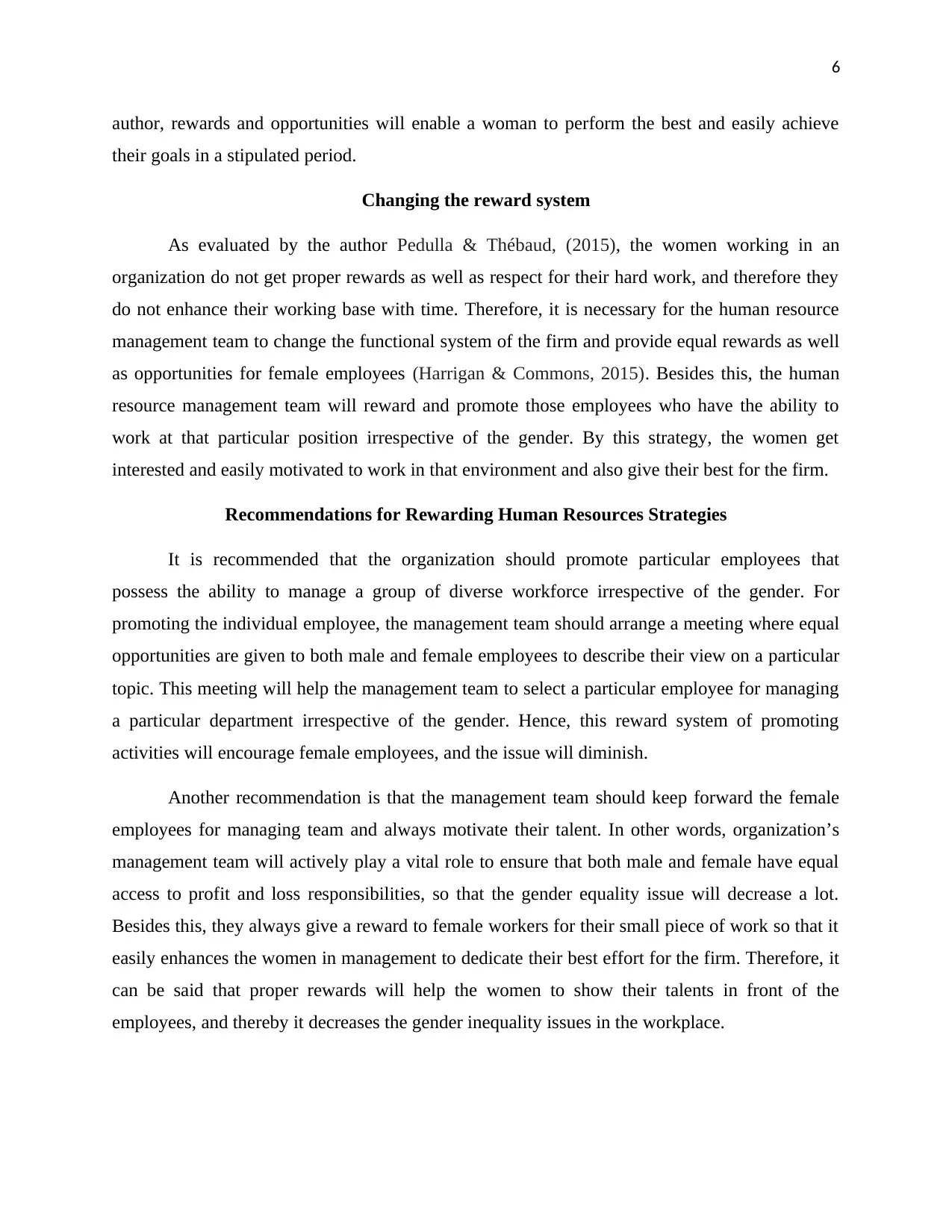
6
author, rewards and opportunities will enable a woman to perform the best and easily achieve
their goals in a stipulated period.
Changing the reward system
As evaluated by the author Pedulla & Thébaud, (2015), the women working in an
organization do not get proper rewards as well as respect for their hard work, and therefore they
do not enhance their working base with time. Therefore, it is necessary for the human resource
management team to change the functional system of the firm and provide equal rewards as well
as opportunities for female employees (Harrigan & Commons, 2015). Besides this, the human
resource management team will reward and promote those employees who have the ability to
work at that particular position irrespective of the gender. By this strategy, the women get
interested and easily motivated to work in that environment and also give their best for the firm.
Recommendations for Rewarding Human Resources Strategies
It is recommended that the organization should promote particular employees that
possess the ability to manage a group of diverse workforce irrespective of the gender. For
promoting the individual employee, the management team should arrange a meeting where equal
opportunities are given to both male and female employees to describe their view on a particular
topic. This meeting will help the management team to select a particular employee for managing
a particular department irrespective of the gender. Hence, this reward system of promoting
activities will encourage female employees, and the issue will diminish.
Another recommendation is that the management team should keep forward the female
employees for managing team and always motivate their talent. In other words, organization’s
management team will actively play a vital role to ensure that both male and female have equal
access to profit and loss responsibilities, so that the gender equality issue will decrease a lot.
Besides this, they always give a reward to female workers for their small piece of work so that it
easily enhances the women in management to dedicate their best effort for the firm. Therefore, it
can be said that proper rewards will help the women to show their talents in front of the
employees, and thereby it decreases the gender inequality issues in the workplace.
author, rewards and opportunities will enable a woman to perform the best and easily achieve
their goals in a stipulated period.
Changing the reward system
As evaluated by the author Pedulla & Thébaud, (2015), the women working in an
organization do not get proper rewards as well as respect for their hard work, and therefore they
do not enhance their working base with time. Therefore, it is necessary for the human resource
management team to change the functional system of the firm and provide equal rewards as well
as opportunities for female employees (Harrigan & Commons, 2015). Besides this, the human
resource management team will reward and promote those employees who have the ability to
work at that particular position irrespective of the gender. By this strategy, the women get
interested and easily motivated to work in that environment and also give their best for the firm.
Recommendations for Rewarding Human Resources Strategies
It is recommended that the organization should promote particular employees that
possess the ability to manage a group of diverse workforce irrespective of the gender. For
promoting the individual employee, the management team should arrange a meeting where equal
opportunities are given to both male and female employees to describe their view on a particular
topic. This meeting will help the management team to select a particular employee for managing
a particular department irrespective of the gender. Hence, this reward system of promoting
activities will encourage female employees, and the issue will diminish.
Another recommendation is that the management team should keep forward the female
employees for managing team and always motivate their talent. In other words, organization’s
management team will actively play a vital role to ensure that both male and female have equal
access to profit and loss responsibilities, so that the gender equality issue will decrease a lot.
Besides this, they always give a reward to female workers for their small piece of work so that it
easily enhances the women in management to dedicate their best effort for the firm. Therefore, it
can be said that proper rewards will help the women to show their talents in front of the
employees, and thereby it decreases the gender inequality issues in the workplace.
Paraphrase This Document
Need a fresh take? Get an instant paraphrase of this document with our AI Paraphraser
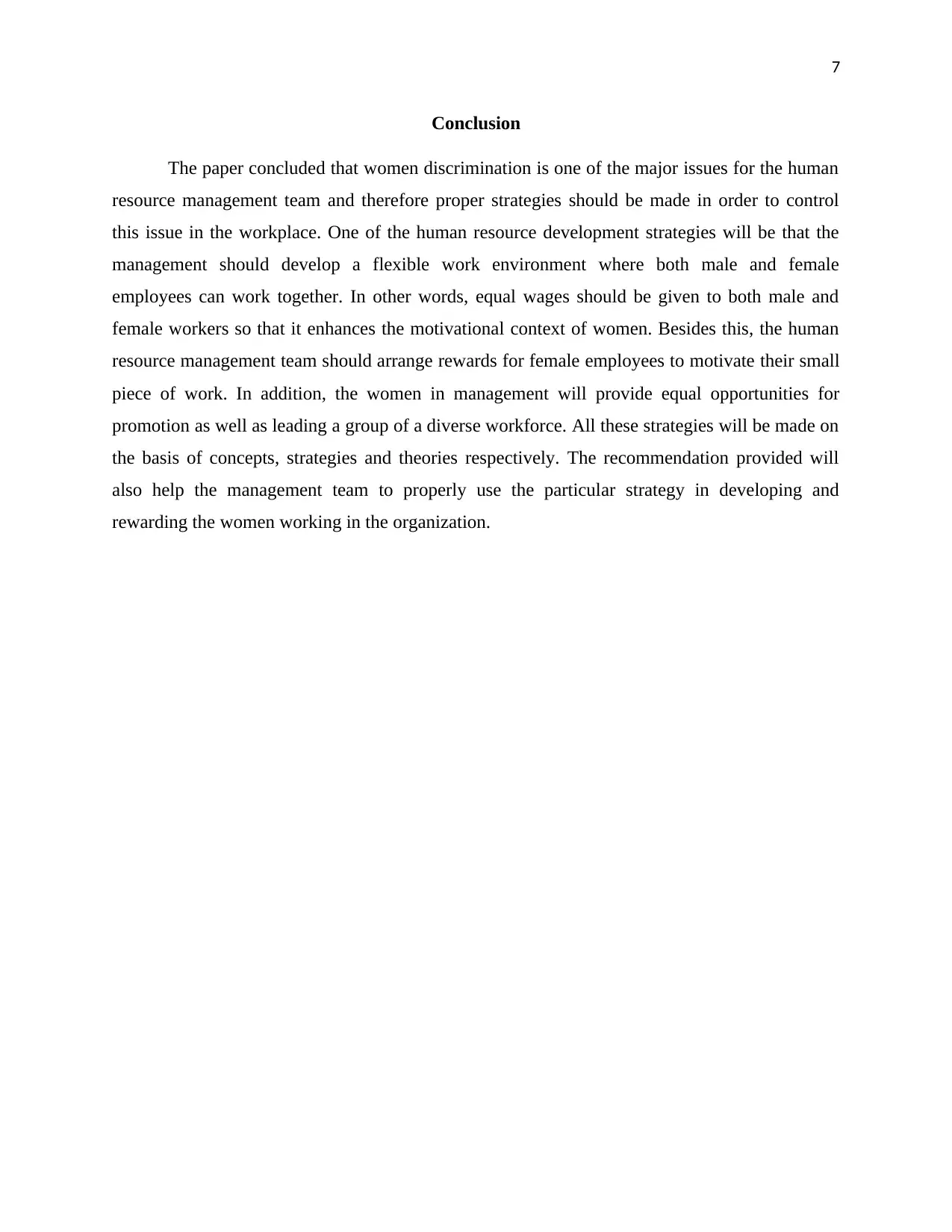
7
Conclusion
The paper concluded that women discrimination is one of the major issues for the human
resource management team and therefore proper strategies should be made in order to control
this issue in the workplace. One of the human resource development strategies will be that the
management should develop a flexible work environment where both male and female
employees can work together. In other words, equal wages should be given to both male and
female workers so that it enhances the motivational context of women. Besides this, the human
resource management team should arrange rewards for female employees to motivate their small
piece of work. In addition, the women in management will provide equal opportunities for
promotion as well as leading a group of a diverse workforce. All these strategies will be made on
the basis of concepts, strategies and theories respectively. The recommendation provided will
also help the management team to properly use the particular strategy in developing and
rewarding the women working in the organization.
Conclusion
The paper concluded that women discrimination is one of the major issues for the human
resource management team and therefore proper strategies should be made in order to control
this issue in the workplace. One of the human resource development strategies will be that the
management should develop a flexible work environment where both male and female
employees can work together. In other words, equal wages should be given to both male and
female workers so that it enhances the motivational context of women. Besides this, the human
resource management team should arrange rewards for female employees to motivate their small
piece of work. In addition, the women in management will provide equal opportunities for
promotion as well as leading a group of a diverse workforce. All these strategies will be made on
the basis of concepts, strategies and theories respectively. The recommendation provided will
also help the management team to properly use the particular strategy in developing and
rewarding the women working in the organization.
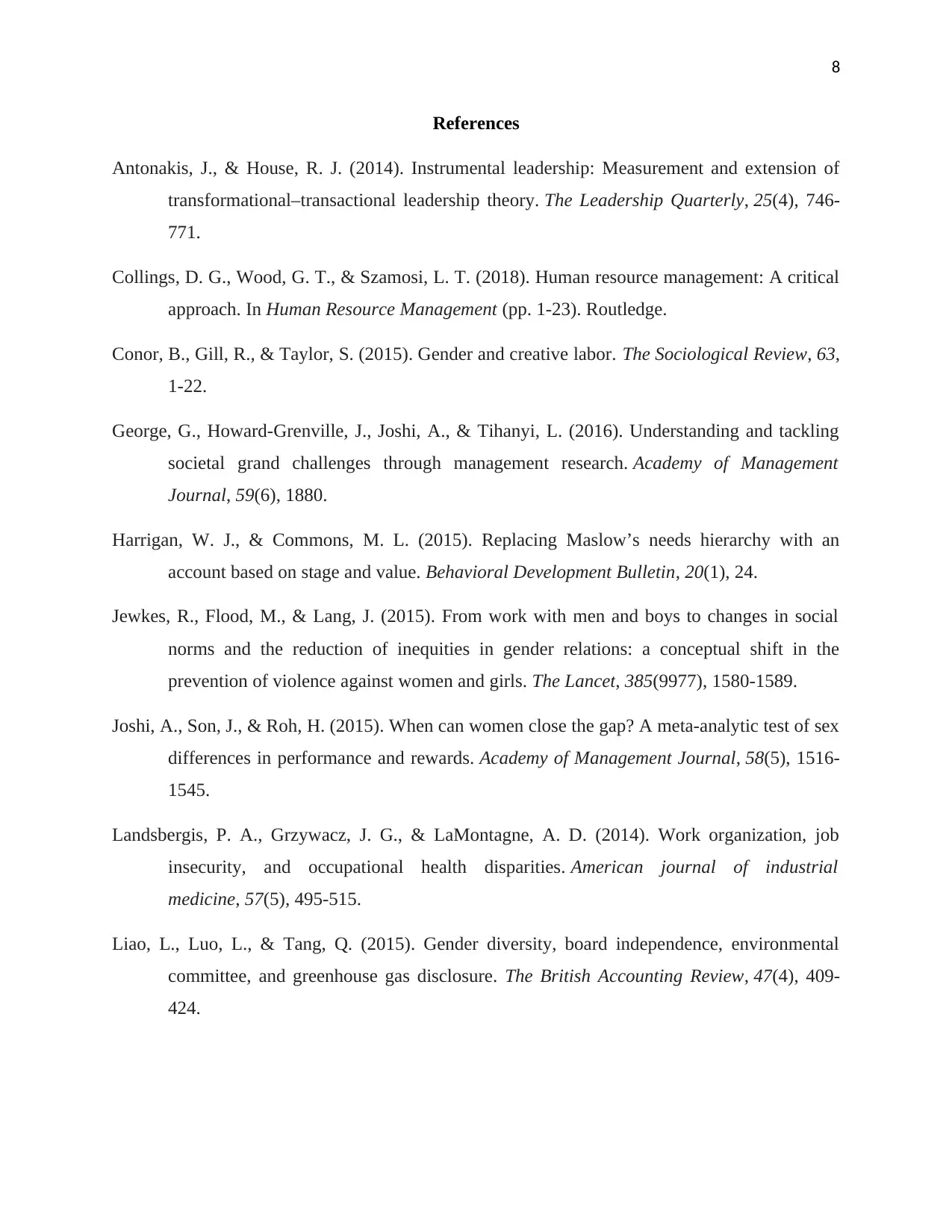
8
References
Antonakis, J., & House, R. J. (2014). Instrumental leadership: Measurement and extension of
transformational–transactional leadership theory. The Leadership Quarterly, 25(4), 746-
771.
Collings, D. G., Wood, G. T., & Szamosi, L. T. (2018). Human resource management: A critical
approach. In Human Resource Management (pp. 1-23). Routledge.
Conor, B., Gill, R., & Taylor, S. (2015). Gender and creative labor. The Sociological Review, 63,
1-22.
George, G., Howard-Grenville, J., Joshi, A., & Tihanyi, L. (2016). Understanding and tackling
societal grand challenges through management research. Academy of Management
Journal, 59(6), 1880.
Harrigan, W. J., & Commons, M. L. (2015). Replacing Maslow’s needs hierarchy with an
account based on stage and value. Behavioral Development Bulletin, 20(1), 24.
Jewkes, R., Flood, M., & Lang, J. (2015). From work with men and boys to changes in social
norms and the reduction of inequities in gender relations: a conceptual shift in the
prevention of violence against women and girls. The Lancet, 385(9977), 1580-1589.
Joshi, A., Son, J., & Roh, H. (2015). When can women close the gap? A meta-analytic test of sex
differences in performance and rewards. Academy of Management Journal, 58(5), 1516-
1545.
Landsbergis, P. A., Grzywacz, J. G., & LaMontagne, A. D. (2014). Work organization, job
insecurity, and occupational health disparities. American journal of industrial
medicine, 57(5), 495-515.
Liao, L., Luo, L., & Tang, Q. (2015). Gender diversity, board independence, environmental
committee, and greenhouse gas disclosure. The British Accounting Review, 47(4), 409-
424.
References
Antonakis, J., & House, R. J. (2014). Instrumental leadership: Measurement and extension of
transformational–transactional leadership theory. The Leadership Quarterly, 25(4), 746-
771.
Collings, D. G., Wood, G. T., & Szamosi, L. T. (2018). Human resource management: A critical
approach. In Human Resource Management (pp. 1-23). Routledge.
Conor, B., Gill, R., & Taylor, S. (2015). Gender and creative labor. The Sociological Review, 63,
1-22.
George, G., Howard-Grenville, J., Joshi, A., & Tihanyi, L. (2016). Understanding and tackling
societal grand challenges through management research. Academy of Management
Journal, 59(6), 1880.
Harrigan, W. J., & Commons, M. L. (2015). Replacing Maslow’s needs hierarchy with an
account based on stage and value. Behavioral Development Bulletin, 20(1), 24.
Jewkes, R., Flood, M., & Lang, J. (2015). From work with men and boys to changes in social
norms and the reduction of inequities in gender relations: a conceptual shift in the
prevention of violence against women and girls. The Lancet, 385(9977), 1580-1589.
Joshi, A., Son, J., & Roh, H. (2015). When can women close the gap? A meta-analytic test of sex
differences in performance and rewards. Academy of Management Journal, 58(5), 1516-
1545.
Landsbergis, P. A., Grzywacz, J. G., & LaMontagne, A. D. (2014). Work organization, job
insecurity, and occupational health disparities. American journal of industrial
medicine, 57(5), 495-515.
Liao, L., Luo, L., & Tang, Q. (2015). Gender diversity, board independence, environmental
committee, and greenhouse gas disclosure. The British Accounting Review, 47(4), 409-
424.
⊘ This is a preview!⊘
Do you want full access?
Subscribe today to unlock all pages.

Trusted by 1+ million students worldwide
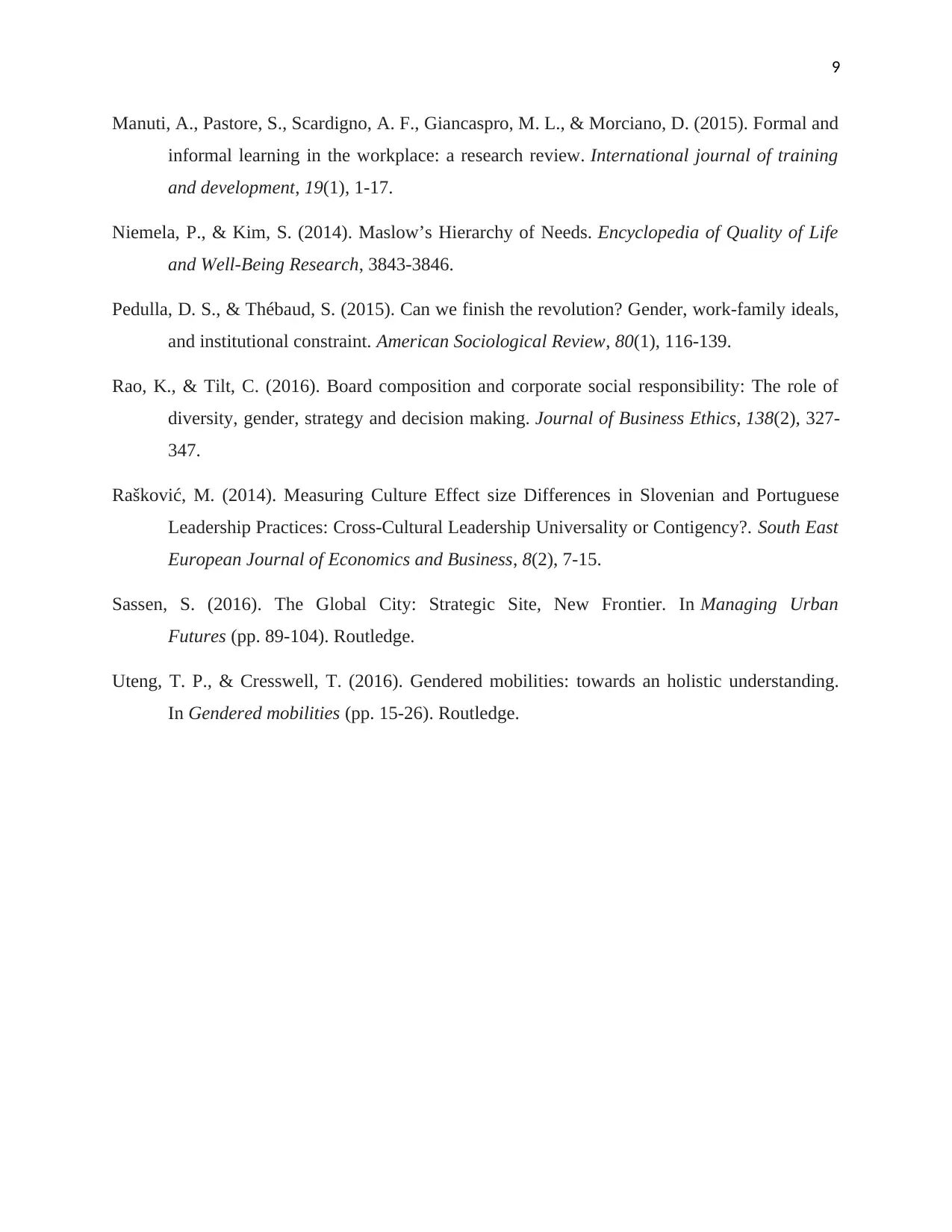
9
Manuti, A., Pastore, S., Scardigno, A. F., Giancaspro, M. L., & Morciano, D. (2015). Formal and
informal learning in the workplace: a research review. International journal of training
and development, 19(1), 1-17.
Niemela, P., & Kim, S. (2014). Maslow’s Hierarchy of Needs. Encyclopedia of Quality of Life
and Well-Being Research, 3843-3846.
Pedulla, D. S., & Thébaud, S. (2015). Can we finish the revolution? Gender, work-family ideals,
and institutional constraint. American Sociological Review, 80(1), 116-139.
Rao, K., & Tilt, C. (2016). Board composition and corporate social responsibility: The role of
diversity, gender, strategy and decision making. Journal of Business Ethics, 138(2), 327-
347.
Rašković, M. (2014). Measuring Culture Effect size Differences in Slovenian and Portuguese
Leadership Practices: Cross-Cultural Leadership Universality or Contigency?. South East
European Journal of Economics and Business, 8(2), 7-15.
Sassen, S. (2016). The Global City: Strategic Site, New Frontier. In Managing Urban
Futures (pp. 89-104). Routledge.
Uteng, T. P., & Cresswell, T. (2016). Gendered mobilities: towards an holistic understanding.
In Gendered mobilities (pp. 15-26). Routledge.
Manuti, A., Pastore, S., Scardigno, A. F., Giancaspro, M. L., & Morciano, D. (2015). Formal and
informal learning in the workplace: a research review. International journal of training
and development, 19(1), 1-17.
Niemela, P., & Kim, S. (2014). Maslow’s Hierarchy of Needs. Encyclopedia of Quality of Life
and Well-Being Research, 3843-3846.
Pedulla, D. S., & Thébaud, S. (2015). Can we finish the revolution? Gender, work-family ideals,
and institutional constraint. American Sociological Review, 80(1), 116-139.
Rao, K., & Tilt, C. (2016). Board composition and corporate social responsibility: The role of
diversity, gender, strategy and decision making. Journal of Business Ethics, 138(2), 327-
347.
Rašković, M. (2014). Measuring Culture Effect size Differences in Slovenian and Portuguese
Leadership Practices: Cross-Cultural Leadership Universality or Contigency?. South East
European Journal of Economics and Business, 8(2), 7-15.
Sassen, S. (2016). The Global City: Strategic Site, New Frontier. In Managing Urban
Futures (pp. 89-104). Routledge.
Uteng, T. P., & Cresswell, T. (2016). Gendered mobilities: towards an holistic understanding.
In Gendered mobilities (pp. 15-26). Routledge.
1 out of 10
Related Documents
Your All-in-One AI-Powered Toolkit for Academic Success.
+13062052269
info@desklib.com
Available 24*7 on WhatsApp / Email
![[object Object]](/_next/static/media/star-bottom.7253800d.svg)
Unlock your academic potential
Copyright © 2020–2025 A2Z Services. All Rights Reserved. Developed and managed by ZUCOL.





